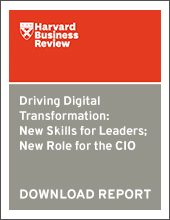A conversation with Phil Garland, CIO of PwC, about disruptive technologies, the pace at which they are changing, and how they're shaping IT careers.
The Enterprisers Project (TEP): Disruptive technologies are a hot topic these days, with everyone talking about the SMAC stack as well as finding the right talent to support it. How do you approach it at PwC?
Phil Garland: Just this week I was talking about the need for the technologist to be more business-savvy and for the people in the business to be more technology-savvy. That blend is very important.
TEP: As a technologist, how do you go about identifying what the truly disruptive technologies are and which ones are the right fit for the business?
Garland: Naturally, our firm is tracking new technologies and the advantage that comes from them. Like most organizations, we have a team of individuals who are constantly reading, meeting with vendors and suppliers, attending conferences, and experimenting with prototypes. We also have an R&D function to look at technology that may be three to five years out before we would start adopting it within the firm.

TEP: Have you noticed an increase in the rate with which technologies change now?
Garland: Oh, yes. Technology is advancing at an exponential rate, to the point where even agile methodologies are too slow and onerous. We need to be even faster. My mindset now is to recognize that if we make a technology selection today, we might very well swap it out and replace it with something more advanced within three to five years.
TEP: So that constant change must shape a new kind of career as well?
Garland: It does. Times have changed from when you would be locked into a multimillion-dollar technology for a long time, just in order to get your return on investment. We all grew up building and implementing big infrastructure and applications, gathering business requirements, and building systems to automate processes. Today, with the progress we see in deep learning, artificial intelligence (AI), neuroscience, and physics, we are creating new, instant analysis platforms with really truly remarkable capabilities. And I think that it’s really a great career opportunity for people who can leverage that into work life and real life. It’s one thing to be out there tinkering and learning and talking to people, but it’s another thing to figure out how to apply that to the business you’re in.
TEP: What sort of barriers will tomorrow’s CIOs face?
Garland: I think the biggest challenge is cultural. Massive change management efforts, fail-fast experimentation, and a willingness to work within constant change all mean you have to be smart about understanding what business processes you’re affecting when you’re making these changes. Too much change too frequently can be very disruptive to the organization. So it’s not just about the technology. It’s about the process change, the cultural change, and the behavioral change. Even in the 1990s, when I was helping clients implement large ERP systems, if a project failed, it was rarely because of the technology. It was often due to a lack of effective or sufficient project management or change management.
That being said, it’s really exciting to see how our clients are becoming more innovative and more willing to experiment and then move on to something better, and not necessarily be married or wedded to old business processes or old technologies.
TEP: So where does the CIO fit in to the acceptance of disruptive technologies?
Garland: I think it’s a real opportunity for us, because the CIO can play a critical role in the education of not just the CEO, but the entire enterprise. We may not be the number-one change champion, but we do play a critical role in that capacity.
Another point is that it’s not just the role of the CIO but the role of IT that has really changed. The IT function today isn’t solely about running an infrastructure or data center and developing applications. IT today is more about being a true technology advisor to the business. This means shifting away from lower-value services and more toward a focus on higher-value, business-focused, business-enabling services. It’s a hard transition for some.
TEP: Are there more successful paths to take in ensuring that technology learning happens, perhaps during the course of business or in some sort of freestanding curriculum?
Garland: I don’t think there is one approach or answer, but I think there are multiple steps a person can take to become more digitally aware as an individual, or to help their organization become more digitally aware.
Really it starts at the college level, or even the secondary school level, linking art and science and putting those two back together again, because a lot of value now that’s offered through technology is the user interface (UI), and that now requires technologists who have a little bit of artist in them as well as a lot of creativity. As you progress in your career, a CEO or business unit leader doesn’t necessarily have to understand a particular technology’s architecture, but they need to understand the benefits and the business value that the new technology provides. On the other side, IT professionals need to have a much deeper understanding and appreciation of the business strategy, the business objectives and the business drivers.
TEP: That’s an interesting insight about the value of the user interface as a focus for learning, because especially in mobile, there’s a very intimate relationship between the user and the mobile device as an object. Understanding that relationship has helped some apps ramp up much faster than others.
Garland: You’re right about that. What organization is not conducting more and more of their business through mobile devices, whether it’s a tablet, smartphone or your new watch? That’s where the UI becomes even more important. You think, today, it would be a heck of a challenge to do spread sheet manipulation on a watch, but then you take a broader, more generalist perspective and think, maybe you can through voice. Pretty soon, if all you need to do all your business is talk, you just need a screen to look at so you can see what you’re saying or what the final product looks like.
So to round out this whole point about disruptive technologies, part of the education is your business getting technology-savvy, part of it is technology getting business-savvy, but part of it is considering many different stakeholders: artists, UI designers, architects, and data scientists. I think it’s very difficult to rise to higher levels of IT now as a specialist. You really have to be more of a generalist, now, and have a good understanding of, I hate to say it, but of everything! It’s more about understanding the big picture now than understanding the nuances of designing and building your data center architecture.
ALSO READ
Philip Garland is a Partner at PwC and serves as Chief Information Officer for the US firm. In this capacity, Mr. Garland is responsible for the design and enhanced technology infrastructure for the future, improving the user experience and ensuring that technology appropriately aligns with and enables the firm’s businesses and strategic support functions. He is also responsible for ensuring that PwC’s IT team is operating efficiently to enable PwC to be an early adopter of technology, respond to change with agility and deploy value for our clients.




